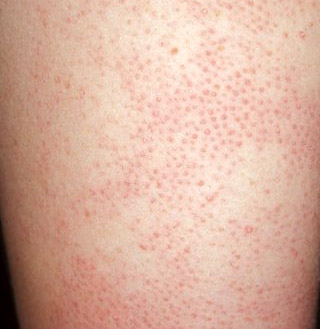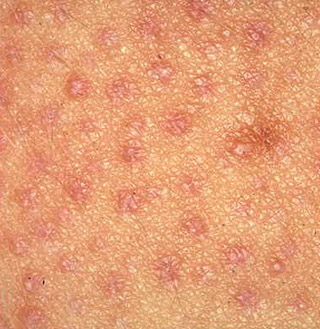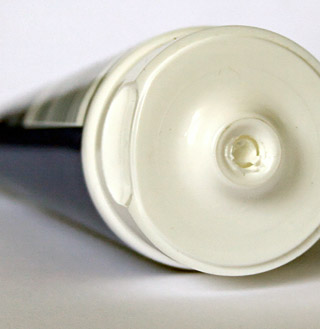Keratosis pilaris
Keratosis pilaris (KP) is a very common genetic follicular condition that is manifested by the appearance of rough bumps (which may be skin coloured, red or brown) on the skin and hence colloquially referred to as "chicken skin". It most often appears on the back and outer sides of the upper arms (though the lower arms can also be affected), and can also occur on the thighs and tops of legs, flanks, buttocks or practically any body part but generally not the palms or soles of the feet. Less commonly, lesions appear on the face and may be mistaken for acne. Although unsightly at times, it is completely harmless.
There are several different types of keratosis pilaris, including keratosis pilaris rubra (red, inflamed bumps), alba (rough, bumpy skin with no irritation), rubra faceii (reddish rash on the cheeks) and keratosis spinulosa (solitary or multiple patches of follicular papules topped with scaly spines on any part of the body). Children, growing adolescents, pregnant and post-partum women suffer from keratosis pilaris more than any other group. For most people it tends to subside in adulthood and disappear in older age, though a mineral-deficient or high-sugar diet may cause the condition to persist.
causes
Keratosis pilaris is genetic in origin but the precise cause has not yet been determined. It is a condition in which the body is having difficulty utilizing calcium. Pores in the skin won't function properly when they don't receive the calcium and magnesium they need. Keratosis pilaris occurs when excess keratin, a natural protein in the skin, accumulates within the hair follicles and forms hard plugs (a process known as hyperkeratinization).
treatment
There is no cure for Keratosis pilaris, though it may improve with age and even disappear completely in adulthood; however, some will show signs of keratosis pilaris for life. Treatments are largely symptomatic and must be repeated. Regardless, exfoliation, intensive moisturizing cremes, lac-hydrin, and medicated lotions containing alpha-hydroxy acids or urea may be used to temporarily improve the appearance and texture of affected skin.
Taking calcium supplements alone will not cure Keratosis pilaris, as it is not a deficiency, but a utilization problem. However, there are supplements specifically designed to help the body process calcium which in turn allow the pores to function properly, thereby smoothing out the skin and alleviating this condition. Sugar consumption and foods with a high glycemic rating should also be reduced if possible, as sugar flushes calcium from the body at a higher rate.
Scratching and picking at KP bumps causes them to redden (if they do not already appear red), and in many cases will cause bleeding. Excessive picking can lead to scarring. Wearing clothing that is looser around the affected areas can also help reduce the marks, as constant chafing from clothing (such as tight fitting jeans) is similar to repeatedly scratching the bumps.
Many KP bumps contain an ingrown hair that has coiled. This is a result of the ketanized skin "capping off" the hair follicle, preventing the hair from exiting. Instead, the hair grows inside the follicle, often encapsulated, and can be removed if the bump is picked our squeezed (which can lead to scarring).
more information
Keratosis Pilaris Info CentralBritish Assoc. of Dermatologists
DermNet NZ


